Translate this page into:
Drug resistance profiles of Gram-negative bacilli isolated from clinical samples in Cross River State, Nigeria

*Corresponding author: Emmanuel Onyekachukwu Ibeneme, Medical Laboratory Science, University of Calabar, Calabar, Cross River, Nigeria. ibeneme.eo@gmail.com
-
Received: ,
Accepted: ,
How to cite this article: Ulom UI, Ibeneme EO, Eyo AO, Asuquo AE, Utsalo SJ. Drug resistance profiles of Gram-negative bacilli isolated from clinical samples in Cross River State, Nigeria. Calabar J Health Sci 2022;6:92-9.
Abstract
Objectives:
Resistance of Gram-negative bacilli (GNB) to antimicrobial agents is increasing worldwide. This is fast becoming a serious public health concern as these bacteria display multiple antibiotic resistance mechanisms. This study was aimed at evaluating antibiotic resistance profiles of GNB from clinical samples in Cross River State, Nigeria.
Material and Methods:
Urine and stool samples of 600 randomly selected participants were analyzed. Samples were inoculated onto CLED agar and selenite-F broth, respectively, and enriched bacterial growth in selenite-F broth was subcultured on deoxycholate citrate agar. Gram stain procedure was used to determine the Gram reaction of isolates and identification was carried out using the Microbact 24E GNB identification kit. Antibiotic susceptibility testing was performed using the Kirby–Bauer disk diffusion method. Multiple antibiotic resistance indices (MARIs) for each isolate were calculated. Data analysis was carried out using Microsoft Excel Package 2016 and GraphPad Prism version 6.
Results:
A total of 129 non-repetitive GNB were isolated and categorized by their ability to ferment sugars. The lactose-fermenting Enterobacteriaceae (LFE) were the most predominant isolates (32 Klebsiella pneumoniae and 25 Escherichia coli). There were 50 non-sugar-fermenting Gram-negative bacilli (NSF-GNB) comprising Pseudomonas spp. (28), Acinetobacter spp. (15), Burkholderia cepacia (3), and one isolate each of Tatumella ptyseos, Alcaligenes faecalis, Aeromonas hydrophila, and Stenotrophomonas maltophilia. Non-lactose-fermenting Enterobacteriaceae comprised Proteus spp. (14), Providencia stuartii (4), and Serratia rubidaea (4). Antimicrobial susceptibility test results showed that tetracycline was the least effective with 71.3% of isolates showing resistance. About 65% of LFE and 95.5% of non-lactose-fermenting Enterobacteriaceae (NLFE) showed resistance to tetracycline. Resistance of all isolates to tigecycline, a member of a new class of antibiotics, was 31% (40/129); however, all isolates of E. coli, S. rubidaea, and Acinetobacter spp. were susceptible to tigecycline. Resistance profiles of LFE to tested antibiotics showed comparable resistance levels for ceftriaxone and tetracycline between K. pneumoniae and E. coli. However, the resistance of K. pneumoniae to ceftazidime, ciprofloxacin, and tigecycline was 50%, 44%, and 13% compared with E. coli – 32%, 32%, and 0%, respectively. E. coli showed, on average, higher resistance levels to carbapenems compared with K. pneumoniae. Among NLFE, Proteus spp. was more resistant than P. stuartii to cephalosporins, quinolones, and tigecycline. In contrast, P. stuartii isolates were twice as resistant to the carbapenems as Proteus spp. Except for ciprofloxacin, tetracycline, and gentamicin, S. rubidaea was susceptible to all other antibiotics. Among NSF-GNB, Acinetobacter spp. was the most resistant to all other carbapenems, except ertapenem. Pseudomonas spp. were the most resistant to fluoroquinolones. The mean of the total MARI was 0.45 ± 0.26, with 54.3% (70/129) of isolates having MARI above the total mean. About 73% (95/129) of the total GNB had MARI above 0.2. Multidrug resistance in Enterobacteriaceae, Pseudomonas aeruginosa, and Acinetobacter species was 53.2%, 100%, and 93.3%, respectively.
Conclusion:
The high level of antibiotic resistance of GNB, especially by NLFE and NSF-GNB, portends great danger for the health sector as these organisms are opportunistic pathogens and pose serious health risks as nosocomial pathogens and community-acquired pathogens in immunosuppressed individuals.
Keywords
Multidrug resistance
Gram-negative bacilli
Clinical samples
Cross River State
INTRODUCTION
Multidrug-resistant (MDR) Gram-negative bacilli (GNB) are important bacterial pathogens that constitute a “clear and present danger” to public health worldwide.[1] The phenomenon of antimicrobial resistance (AMR) is an increasing concern in clinical settings, which challenges effective prevention and treatment of several bacterial infections caused by MDR GNB.[2,3] GNB are among the bacteria that exhibit remarkable levels and varying mechanisms of antibiotic resistance and are the most common causative agents of infectious diseases.[4] The most common infectious diseases caused by GNB include, among others, urinary tract infections (UTIs) and intra-abdominal infections (IAIs).[3] These organisms and other GNB are major causes of morbidity and mortality in developing countries,[3] including Nigeria.
GNB tend to leverage their innate resistance as well as acquired resistance to antibiotics, giving them the ability to become MDR, a term that refers to the simultaneous resistance to several antibiotics belonging to various classes and subclasses.[2] These MDR organisms are often a cause of treatment failures due to their broad spectrum of antibiotic resistance,[4] making them a nagging problem in healthcare facilities.[5] MDR GNB are likely to cause higher morbidity and death, particularly among significantly immunocompromised patients with underlying diseases.[5] Infections that arise from MDR GNB adversely affect treatment outcomes, costs, disease spread, duration of illnesses, and subsequent hospitalizations, posing a serious challenge to future antibiotic chemotherapy.[2]
AMR is a major concern in developing countries, which bear the burden of infectious diseases, due to a lack of proper disease surveillance networks, inadequate and/or obsolete laboratory capacity, and inappropriate diagnostic tools.[6] The inappropriate and/or irrational use of antibiotics, which are readily available over-the-counter; the half-baked practice of antimicrobial susceptibility testing;[2] poor adherence, use of counterfeit, and sub-standard antibiotics; and poor infection control practices,[6] compound the problem both in hospital and community-acquired infections.[2]
In developing countries like Nigeria, infectious diseases with antibiotic-resistant bacteria become a real threat. Hence, regular and adequate monitoring of local levels of AMR patterns and trends is key to guiding the rational use of antibiotics and containing the spread of drug-resistant bacteria.[2,7,8] Therefore, this study aimed to determine the antibiotic resistance pattern of GNB isolated from urine and stool samples of hospitalized and outpatients of selected medical facilities in Cross River State, Nigeria.
MATERIAL AND METHODS
Ethical considerations
This study was conducted under the Helsinki Declaration of 1975 (as revised in 2000) and approved by the Medical Research Ethics Committee of the Cross River State Government of Nigeria (Reference Number: CRS/MH/CGS/ E-H/018/Vol. II/116). Informed consent was obtained from study participants before they were recruited to the study; original copies of informed consent forms are securely stored in the lead author’s office.
Study participants and sample collection
Urine and stool samples were obtained from randomly selected 600 male and female participants who attended selected health facilities across Cross River State. Inclusion criteria were patients (either in or out-patients) who voluntarily agreed to participate in the study; patients who were not willing to participate in the study were excluded from the study. Questionnaires were also administered to the study participants, to ascertain their demographic characteristics and clinical history.
Bacteriological examination of samples
A total number of 600 (405 urine and 195 stool) samples were collected from 405 participants. All urine samples were cultured onto CLED agar, while stool samples were inoculated into selenite-F broth and the enriched growth was subcultured onto deoxycholate citrate agar. The cultured plates were thereafter incubated at 37°C for 24 h. Pure isolates were maintained on nutrient agar slants overlaid with paraffin oil. Preliminary identification of isolated pathogens was done using colonial appearance and Gram staining technique. From the stock cultures, species identification of isolates was made by the use of Microbact GNB 12A and 24E identification kit (Oxoid, Basingstoke, UK).
Antibiotic sensitivity testing
Antibiotic susceptibility testing was carried out using the modified Kirby–Bauer disk diffusion method and the inocula were prepared using the direct colony suspension method as recommended by the Clinical and Laboratory Standards Institute.[9] Ten antibiotics were tested: Ertapenem – 10 ᶙg, imipenem – 10 ᶙg, doripenem – 10 ᶙg, ceftriaxone – 30 ᶙg, ceftazidime – 30 ᶙg, ciprofloxacin – 5 ᶙg, ofloxacin – 5 ᶙg, tetracycline – 30 ᶙg, tigecycline – 15 ᶙg, and gentamicin – 10 ᶙg (Oxoid, Basingstoke, UK). Multiple antibiotic resistance indices (MARIs) for each isolate were calculated.
The isolates were first subcultured onto nutrient agar from the stock cultures and incubated for 24 h at 37°C to obtain discrete colonies. Two or three colonies were suspended in 4 mL of 0.9% NaCl solution in a sterile sample bottle and properly shaken to homogenize the bacteria cells. The suspensions were then adjusted to a turbidity equivalent of 0.5 McFarland standard. Within 15 min of the adjustment, sterile cotton swabs were dipped into each suspension and evenly streaked over the surface of Mueller-Hinton agar plates. The plates were allowed for about 3–5 min to absorb the culture before application of the standard antibiotic disks with the aid of sterile forceps. The plates were thereafter incubated at 37°C for not <18 h, after which the diameters of the resulting zones of inhibition were measured to the nearest whole millimeter.
Determination of MARIs of isolates
MARI of each isolate was calculated as the ratio of the number of antibiotics to which a particular isolate is resistant, to the number of antibiotics tested against the isolate (MAR = No. of antibiotics to which an isolate is resistant/No. of antibiotics tested against the isolate).[10]
Three MDR indices (MDR; extreme drug resistance; and pan drug resistance) of groups of isolates were calculated, based on a proposal by medical professionals of the United States and European Centres for Disease Control and Prevention.[11]
Data Analysis
Datasets were represented using frequencies, pie charts, and bar charts. Mean and standard deviations of value sets were calculated and one-way Analysis of variance test was used to analyze differences in the level of antibiotic resistance between the three groups of GNB. Data analyses were carried out using Microsoft Excel Package 2016 and GraphPad Prism version 6. P < 0.05 was considered statistically significant.
RESULTS
Categories of isolates
Of the 129 GNB, 57 (44%) were identified as lactose-fermenting Enterobacteriaceae (LFE), 22 (17%) as nonlactose-fermenting Enterobacteriaceae (NLFE), and 50 (39%) as non-sugar-fermenting GNB (NSF-GNB) [Figure 1].

- Distribution of Gram-negative bacilli based on sugar fermentation profiles. LFE: Lactose-fermenting Enterobacteriaceae; NLFE: Non-lactose-fermenting Enterobacteriaceae; NSF-GNB: Non-sugar-fermenting Gram-negative bacilli.
Antibiotic susceptibility testing of isolates
Antibiotic susceptibility testing of isolates showed that imipenem was the most effective antibiotic tested against all GNB, with a resistance rate of 29.5% (38/129), while the least effective antibiotic was tetracycline with a resistance rate of 71.3% (92/129). Of the three groups of GNB, the NSF-GNB showed the greatest antibiotic resistance rates for ceftriaxone, tigecycline, gentamicin, both fluoroquinolones, and all three carbapenems, while the LFE showed the greatest rates for ceftazidime and tetracycline. Among the LFE and NLFE, tetracycline was the least effective antibiotic with resistance rates of 64.9% (37/57) and 95.5% (21/22), respectively [Table 1].
| Antibiotics /GNB | No. of examined | CTR No. (%) | CAZ No. (%) | CIP No. (%) | OFX No. (%) | TE No. (%) | TGC No. (%) | CN No. (%) | ETP No. (%) | IMI No. (%) | DOR No. (%) |
|---|---|---|---|---|---|---|---|---|---|---|---|
| LFE | 57 *(44.2) |
30 *(34.9) **(52.6) |
24 *(45.3)a **(42.1) |
22 *(37.3) **(38.6) |
22 *(40.0) **(38.6) |
37 *(40.2)a **(64.9)b |
4 *(10.0) **(7.0) |
17 *(30.4) **(29.8) |
14 *(21.9) **(24.6) |
14 *(36.8) **(24.6) |
14 *(35.9) **(24.6) |
| NLFE | 22 *(17.1) |
9 *(10.5) **(40.9) |
10 *(18.9) **(45.5) |
13 *(22.0) **(59.1) |
10 *(18.2) **(45.5) |
21 *(22.8) **(95.5)b |
8 *(20.0) **(36.4) |
10 *(17.9) **(45.5) |
5 *(7.8) **(22.7) |
8 *(21.1) **(36.4) |
5 *(12.8) **(22.7) |
| NSF-GNB | 50 *(38.7) |
47 *(54.7)a **(94.0)b |
19 *(35.8) **(38.0) |
24 *(40.7)a **(48.0) |
23 *(41.8)a **(46.0) |
34 *(37.0) **(68.0) |
28 *(70.0)a **(56.0) |
29 *(51.8)a **(58.0) |
45 *(70.3)a **(90.0) |
16 *(42.1)a **(32.0) |
20 *(51.3)a **(40.0) |
| Total |
129 (100) |
86 **(66.7) |
53 **(41.1) |
59 **(45.7) |
55 **(42.6) |
92 **(71.3) |
40 **(31.0) |
56 **(43.4) |
64 **(49.6) |
38 **(29.5) |
39 **(30.2) |
Klebsiella pneumoniae had higher resistance levels than Escherichia coli when tested with ceftazidime (50% and 32%, respectively), ciprofloxacin (44% and 32%, respectively), tigecycline (13% and 0%, respectively), and gentamicin (41% and 16%, respectively). On the other hand, K. pneumoniae had lower resistance levels than E. coli when tested with ertapenem, imipenem, and doripenem (22% and 28%, respectively, for all three carbapenems) [Figure 2].
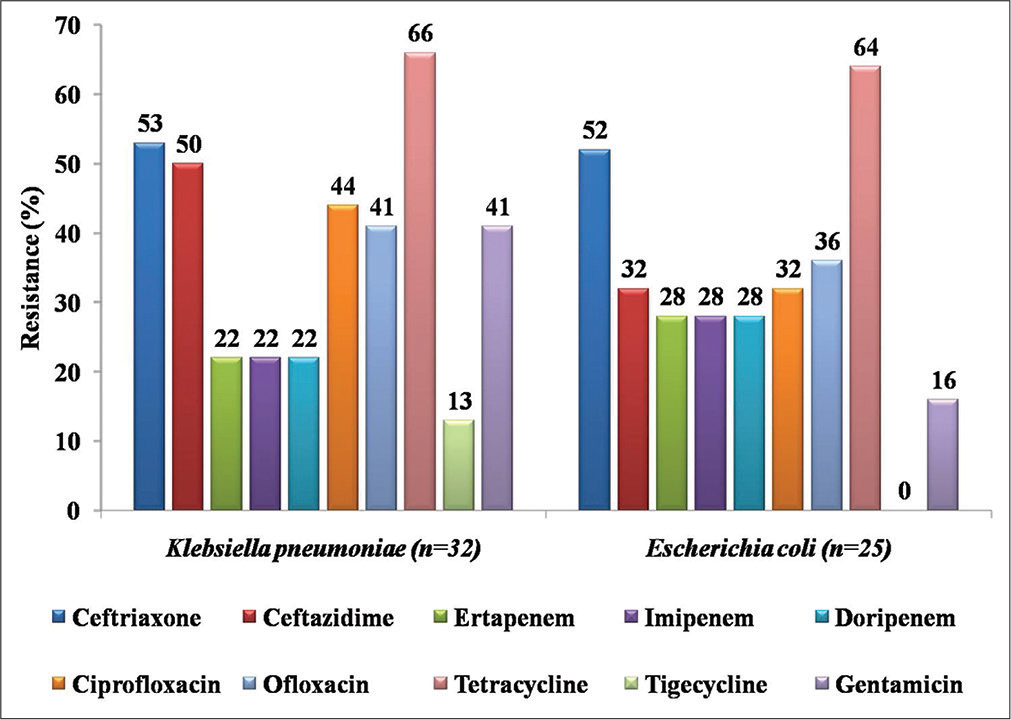
- Antibiotic resistance profile of lactose-fermenting Enterobacteriaceae (Klebsiella pneumoniae and Escherichia coli).
Proteus spp. had higher resistance levels than Providencia stuartii when tested with half of the antibiotics assayed – ceftriaxone, ceftazidime, ciprofloxacin, ofloxacin, and tigecycline. P. stuartii isolates showed twice the level of resistance with ertapenem, imipenem, and doripenem than Proteus spp. [Figure 3].
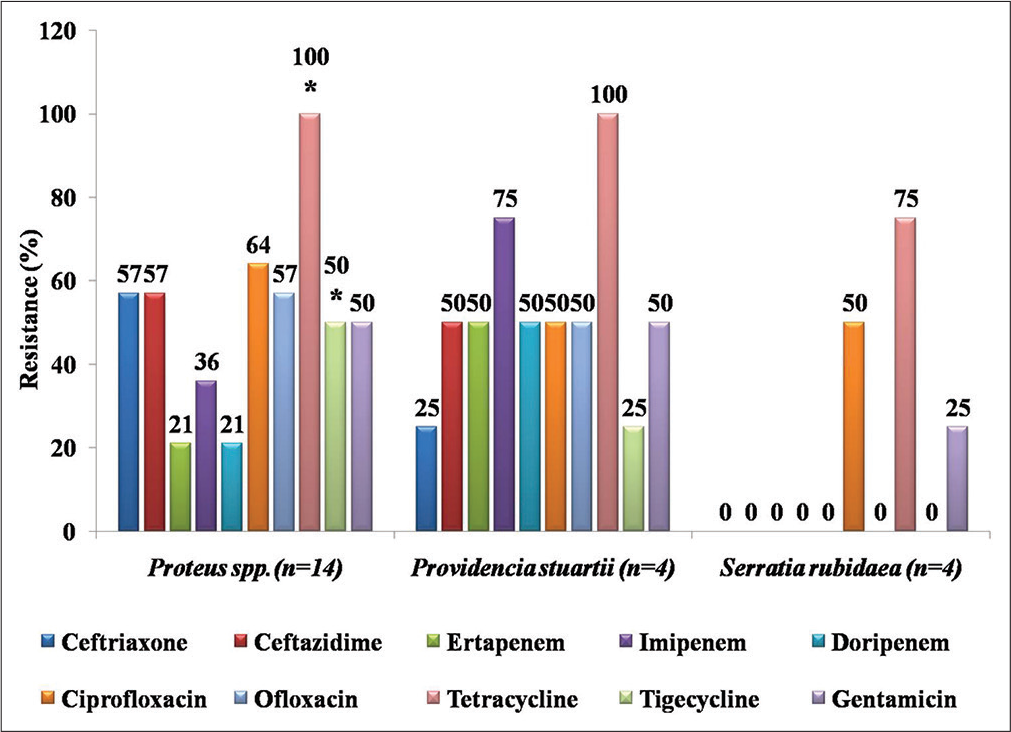
- Antibiotic resistance profile of non-lactose-fermenting Enterobacteriaceae (Proteus mirabilis, Providencia stuartii, and Serratia rubidaea) *Denotes intrinsic resistance.
Pseudomonas species showed higher resistance levels with ceftriaxone, ertapenem, ciprofloxacin, ofloxacin, tigecycline, and gentamicin, than all other NSF-GNB. Acinetobacter spp. showed the highest level of resistance to imipenem and doripenem. Burkholderia cepacia showed the second highest resistance levels to imipenem (33%) and gentamicin (67%) [Figure 4a and b].
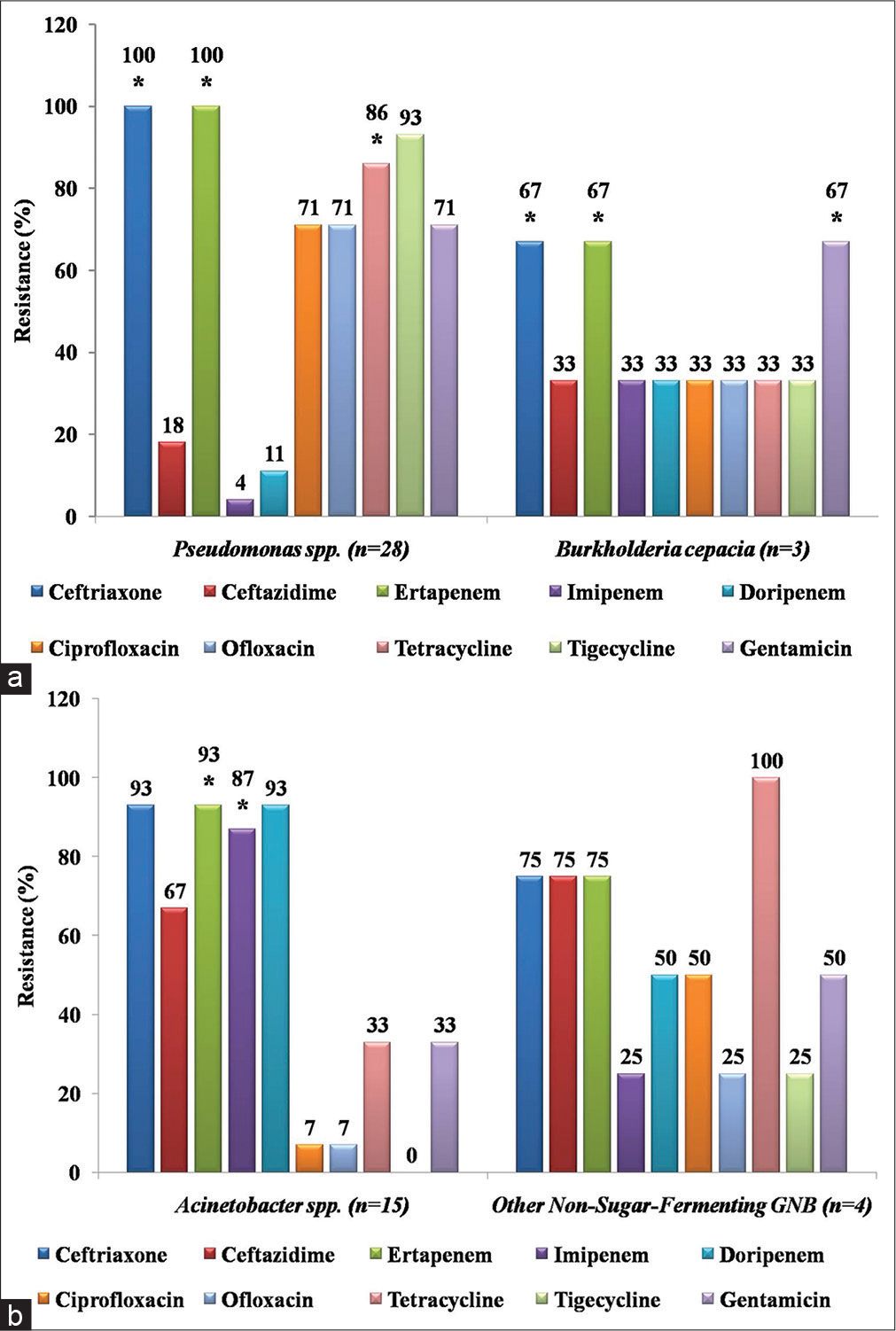
- (a) Antibiotic resistance profile of non-sugar-fermenting Gram-negative bacilli (Pseudomonas spp. and Burkholderia cepacia) *Denotes intrinsic resistance. (b) Antibiotic resistance profile of non-sugar-fermenting Gram-negative bacilli (Acinetobacter spp. and others: Aeromonas hydrophilia-1, Tatumella ptyseos-1, Alcaligenes faecalis-1, and Stenotrophomonas maltophilia-1) *Denotes intrinsic resistance.
Determination of MARIs of isolates
The mean MARI of all GNB was 0.45 ± 0.26 [Figure 5]. Lactose-fermenting Enterobacteriaceae had an overwhelmingly higher number of isolates with MARI of 0–0.3 when compared with NLFE and NSF-GNB, while all isolates with MARI of 1.0 were NLFE [Figure 6].
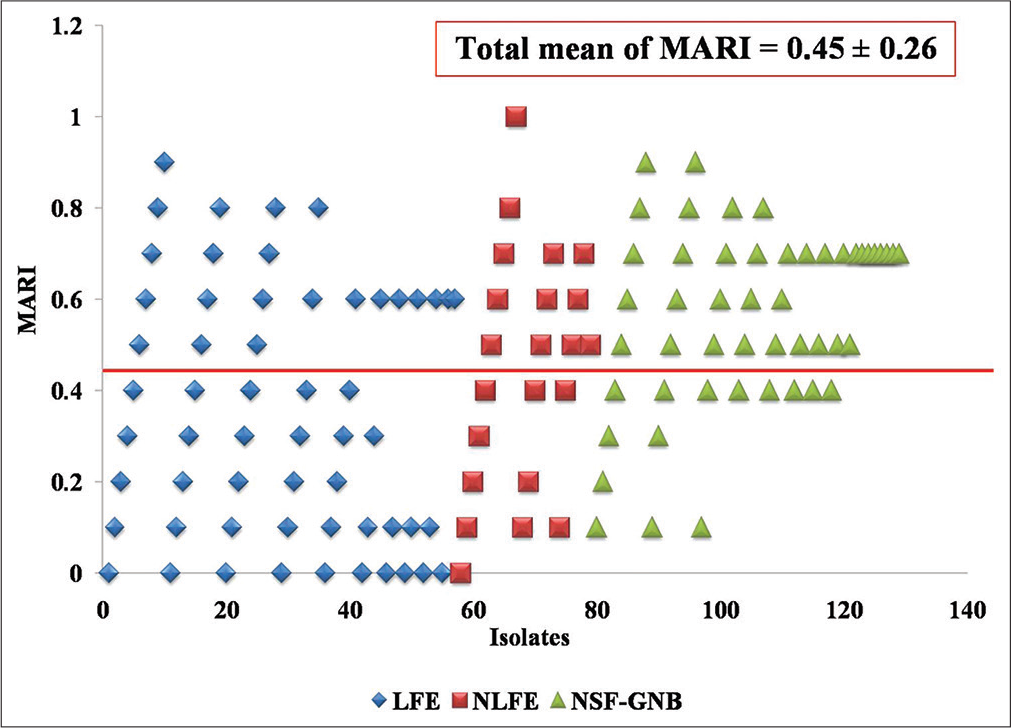
- Distribution of MARI of LFE, NLFE, and NSF-GNB categories of Gram-negative bacilli: Cutoff line at total mean of 0.45. MARI: Multiple antibiotic resistance index, LFE: Lactose-fermenting Enterobacteriaceae, NLFE: Non-lactose-fermenting Enterobacteriaceae, NSF-GNB: Non-sugar-fermenting Gram-negative bacilli.
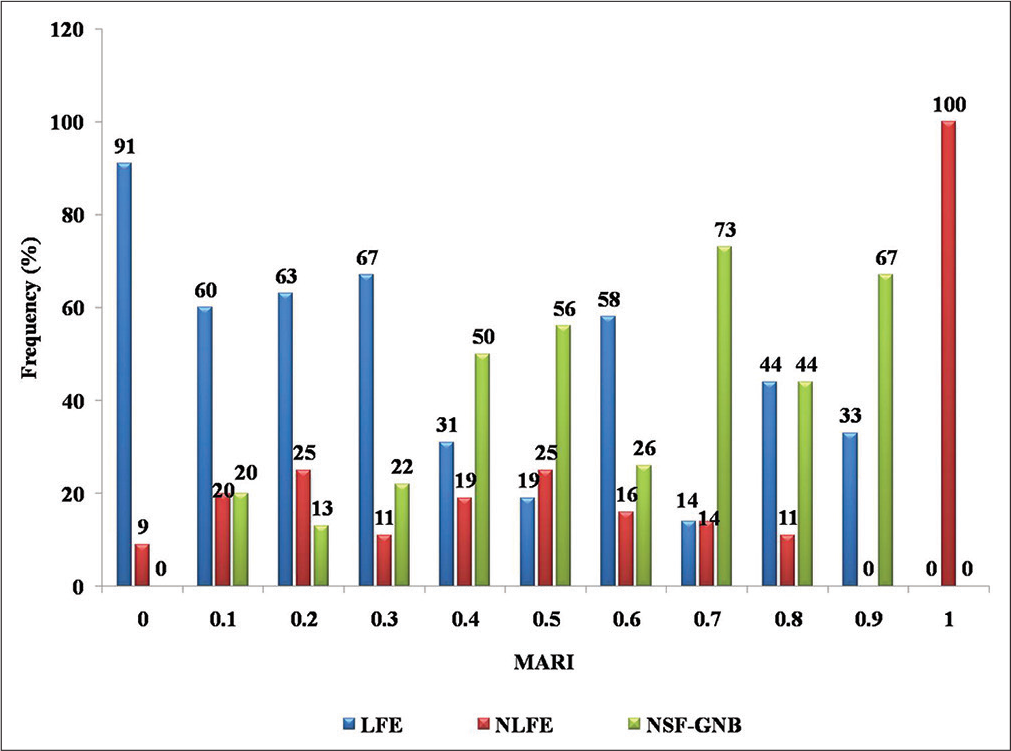
- Frequency of LFE, NLFE, and NSF-GNB categories of Gram-negative bacilli in relation to MARI. MARI: Multiple antibiotic resistance index, LFE: Lactose-fermenting Enterobacteriaceae, NLFE: Non-lactose-fermenting Enterobacteriaceae, NSF-GNB: Non-sugar-fermenting Gram-negative bacilli.
The mean MARIs of LFE, NLFE, and NSF-GNB were 0.35 ± 0.27, 0.45 ± 0.25, and 0.56 ± 0.20, respectively. Of the 129 GNB, 70 (54.3%) had MARI above the total mean, whereas 22 (38.6%), 12 (54.5%), and 36 (72.0%) of LFE, NLFE, and NSF-GNB, respectively, had MARI above the total mean. About 73% (95/129) of the total GNB had MARI above 0.2, while 57.9% (33/57) of LFE, 72.7% (16/22) of NLFE, and 92% (46/50) of NSF-GNB had MARI above 0.2 [Table 2].
| Isolates | No. of examined | Mean MARI±SD | No. (%) of isolates with MARI | |
|---|---|---|---|---|
| Above total mean | Above 0.2 | |||
| LFE | 57 | 0.35±0.27 | 22 (38.6) | 33 (57.9) |
| NLFE | 22 | 0.45±0.26 | 12 (54.5) | 16 (72.7) |
| NSF-GNB | 50 | 0.56±0.20 | 36 (72.0) | 46 (92.0) |
| TOTAL | 129 | 0.45±0.26 | 70 (54.3) | 95 (73.6) |
MARI: Multiple antibiotic resistance index, LFE: Lactose-fermenting Enterobacteriaceae, NLFE: Non-lactose-fermenting Enterobacteriaceae, NSF-GNB: Non-sugar-fermenting Gram-negative bacilli
Analysis of variance of the means of MARI of LFE, NLFE, and NSF-GNB [Table 3] showed that only the mean difference between LFE and NSF-GNB out of the three mean differences was statistically significant at P < 0.05.
| Isolate categories comparisons | Mean difference | 95% CI of difference | P-value* | Remark |
|---|---|---|---|---|
| LFE versus NLFE | −0.09912 | (−0.2443–0.04609) | 0.241 | NS |
| LFE versus NSF-GNB | −0.2091 | (−0.3212–−0.09702) | <0.0001 | S |
| NLFE versus NSF-GNB | −0.1100 | (−0.2580–0.03802) | 0.187 | NS |
MDR status analysis of isolates [Table 4] showed that more than 50% of all categories of isolates were MDR; all Pseudomonas aeruginosa isolates and all GNB showed 100% and 62% MDR, respectively.
| Isolates | No. of isolated | MDR isolates – No. (%) |
|---|---|---|
| Enterobacteriaceae | 79 | 42 (53.2) |
| Pseudomonas aeruginosa | 17 | 17 (100) |
| Acinetobacter species | 15 | 14 (93.3) |
| All Gram-negative bacilli | 129 | 80 (62.0) |
MDR: Multidrug resistance
DISCUSSION
In the present study, K. pneumoniae and E. coli were the most common GNB and only lactose fermenters were isolated, making up to 44% of the total number of Gram-negative rods. A similar finding was reported elsewhere.[3] E. coli is regarded as the most common uropathogen, responsible for approximately 80% of UTIs,[12] and has a significant presence in the human gut.[13] Non-lactose-fermenting Enterobacteriaceae are not incriminated as much as lactose fermenters in UTIs,[12] probably giving rise to their low rate of isolation of 17% in this study.
Non-sugar-fermenting GNB accounted for 39% of all isolates in this study. Their significance in infectious diseases is without a doubt as they have been reported to account for about 15% of all bacterial isolates from clinical microbiology laboratories.[14]
In the present study, antibiotic susceptibility testing revealed that tetracycline was the least effective antibiotic tested against all GNBs. This result corroborates other studies in Nigeria that reported resistance rates in excess of 80%.[15,16] Tetracycline is a common over-the-counter antibiotic used in Nigeria in the treatment of diarrhea,[17] a frequently occurring ailment among Nigerians. The drug is most often abused by discontinued use after the diarrhea episodes are brought under control, and as prophylaxis for anticipated intestinal disturbances. The high level of resistance to tetracycline observed in this study could be related to the high rate of self-medication of this drug in the study area.[18]
Imipenem, on the other hand, was the most effective antibiotic in this study. This result is expected as with results from other studies which reported high sensitivity of uropathogens to imipenem.[8,19] This low resistance rate detected for imipenem may be associated with its relatively uncommon use in clinical settings, either as an empirical treatment only in hospitalized patients or according to culture and sensitivity results.[8]
In this study, all GNB showed low levels of resistance to tigecycline except for Proteus spp. (50%) and Pseudomonas spp. (93%). Tigecycline is a relatively new drug, being the first member of a brand new class of antibiotics, glycylcyclines, approved by the United States Food and Drug Administration for the treatment of complicated skin, soft tissue, and IAIs.[20] It is not easily available in Nigeria[17] and may have shown high antibacterial activity in the geographical region because of its lack of use.[21] However, the low level of resistance observed may be attributed to the overexpression of efflux pumps or probably other mechanisms of resistance to new antibiotics which usually exist before the introduction of the antibiotic in the clinics.[17,22,23] Tigecycline demonstrated good in vitro activity against MDR Acinetobacter isolates in this study. Tigecycline had shown promise in the treatment of MDR Acinetobacter infections[24] and proved to be an effective therapy in patients with MDR-Acinetobacter spp.-related respiratory infections.[20]
In the present study, the mean MARI of 0.45 is far higher than 0.2, which is the cutoff value for identifying isolates from a “high-risk” source of contamination: 73.6% (95/129) of all GNBs had MARI above 0.2. The mean MARIs of NLFE and NSF-GNB were respectively equal to and greater than the overall mean MARI of GNB: More than half of the number of each NLFE and NSF-GNB had MARI above the overall mean. Non-fermenters generally exhibit a great degree of intrinsic resistance and have been designated as a major emerging cause of MDR in the world. This may be attributed to their free-living nature in the environment which exposes them to low doses of numerous antibiotics over time, creating selective pressure and resulting in the development of inherent (chromosomally mediated) antibiotic resistance.[25] The resistance genes they possess are mostly chromosomally mediated; they may also possess plasmid-mediated resistance genes which may be transferred to other Gram-negative bacteria.[14] In this study, Pseudomonas and Acinetobacter, and Proteus were the most recurring NSF-GNB and NLFE, respectively.
In addition to ceftriaxone, ertapenem, and tetracycline to which P. aeruginosa isolates are intrinsically resistant,[26] ciprofloxacin, ofloxacin, tigecycline, and gentamicin showed low activity against the isolates. Except for tigecycline, fluoroquinolones and aminoglycosides are commonly prescribed antibiotics by clinicians in Nigeria. They are also easily obtained from local pharmacies and patent medicine dealers.[27] In most cases, prescriptions and purchases of these antibiotics are made without appropriate bacteriological diagnosis and AST procedure.[17] All these factors create a perfect storm for the increase in the trend of AMR in the country, in general, and the present study area, in particular.[18] Pseudomonas spp. showed very limited resistance to imipenem in this study, as corroborated by results elsewhere,[28] as well as high resistance to gentamicin, as with results elsewhere.[2]
Acinetobacter baumannii, a free-living, opportunistic, and difficult-to-control pathogen, is also known to be highly drug-resistant.[3] Acinetobacter spp. showed the highest level of resistance to carbapenems in this study. The reason for this is that they are intrinsically resistant to ertapenem and imipenem.[26] This intrinsic resistance to carbapenems is mainly due to the production of oxacillinase-type carbapenemases, or more rarely, metallo-beta-lactamases[20,29,30] and to a lesser extent, may be due to reduced outer membrane permeability, increased efflux systems, and alteration of penicillin-binding proteins.[14] Carbapenem-resistant A. baumannii infections are associated with prolonged intensive care units or hospital stays.[20] Therapeutic options available to treat these MDR Acinetobacter infections are limited: [20] Tigecycline (not currently available in Nigeria) and colistin (polymyxin which is not clinically available because of its toxicity) are two antibiotics currently used as a last resort in the treatment of carbapenem-resistant Gram-negative bacterial infections.[20,31,32]
Proteus spp. showed lower than 50% resistance levels only to the three carbapenems assayed. Except for tetracycline and tigecycline, to which they are intrinsically resistant, most Proteus spp. were resistant to all other antibiotics. The moderate level of susceptibility of Proteus spp. to carbapenems could be associated with reduced or nonexistent drug abuse by the population due to their cost, preventing self-medication by patients.[33]
CONCLUSION
In this study, carbapenems were very effective against Proteus spp., imipenem and doripenem were very effective against Pseudomonas spp., while fluoroquinolones and tigecycline were very effective against Acinetobacter spp. The high levels of antibiotic resistance were possibly due to the indiscriminate use of antibiotics for the treatment of various infections, which had been going on for a long time.
A carefully thought-out action plan needs to be in place, as regards antibiotic stewardship, when considering the introduction of new, previously unused drugs, such as tigecycline, into the Nigerian market.
Acknowledgments
The authors thank Mr. Sunday Michael Obeten for permitting part of this work to be carried out in his Reference Laboratory and his team, Mrs. Elizabeth John Okoi and Mrs. Nkoyo Bassey Ukorebi, for their technical and logistical assistance. The authors also thank Mr. Emmanuel Omonigbehin for his technical assistance in the realization of this work.
Declaration of patient consent
Institutional Review Board (IRB) permission obtained for the study.
Financial support and sponsorship
Tertiary Education Trust Fund.
Conflicts of interest
There are no conflicts of interest.
References
- Isolation and characterization of Escherichia coli sequence Type 131 and other antimicrobial-resistant gram-negative bacilli from clinical stool samples from veterans. Antimicrob Agents Chemother. 2016;60:4638-45.
- [CrossRef] [PubMed] [Google Scholar]
- Bacterial agents and antibiotic resistance profiles of infections from different sites that occurred among patients at Debre Markos Referral Hospital, Ethiopia: A cross-sectional study. BMC Res Notes. 2017;10:254-63.
- [CrossRef] [PubMed] [Google Scholar]
- Antimicrobial susceptibility of gram-negative bacilli isolated from intra-abdominal and urinary-tract infections in Mexico from 2009 to 2015: Results from the study for monitoring antimicrobial resistance trends (SMART) PLoS One. 2018;13:1-13.
- [CrossRef] [PubMed] [Google Scholar]
- Understanding the epidemiology of multidrug resistant gram-negative bacilli in the Middle East using a one health approach. Front Microbiol. 2019;10:1-39.
- [CrossRef] [PubMed] [Google Scholar]
- Prevention of Hospital-Acquired Infections: A Practical Guide (2nd ed). Geneva: World Health Organization; 2002.
- [Google Scholar]
- High prevalence of extended-spectrum beta-lactamase-producing gram-negative pathogens from patients attending Felege Hiwot comprehensive specialized hospital, Bahir Dar, Amhara region. PLoS One. 2019;14:e0215177.
- [CrossRef] [PubMed] [Google Scholar]
- Antimicrobial resistance pattern of bacterial isolates from different clinical specimens in South Ethiopia: A three-year retrospective study. Afr J Bacteriol Res. 2016;9:1-8.
- [Google Scholar]
- Antibiotic resistance pattern of bacteria isolated from outdoor patients in Dhaka city: A single center study. Stamford J Microbiol. 2019;9:1-4.
- [CrossRef] [Google Scholar]
- Performance Standards for Antimicrobial Susceptibility Testing; Twenty-Second Informational Supplement (27th ed). Wayne, PA: Clinical and Laboratory Standards Institute; 2014.
- [Google Scholar]
- Multiple antibiotic resistance (MAR) indices of Pseudomonas and Klebsiella species isolates in Lagos University Teaching Hospital. Afr J Cln Exper Microbiol. 2013;14:164-8.
- [CrossRef] [Google Scholar]
- Multidrug-resistant, extensively drug resistant and pandrug-resistant bacteria: An international expert proposal for interim standard definitions for acquired resistance. Clin Microbiol Infect. 2012;18:268-81.
- [CrossRef] [PubMed] [Google Scholar]
- Community-acquired urinary tract infection by Escherichia coli in the era of antibiotic resistance. Biomed Res Intl. 2018;2018:1-14.
- [CrossRef] [PubMed] [Google Scholar]
- Population structure of gut Escherichia coli and its role in development of extra-intestinal infections. Iran J Microbiol. 2010;2:59-72.
- [Google Scholar]
- Emergence of non-fermenting gram negative bacilli as multidrug resistant septicaemia pathogen in a tertiary hospital. Acta Sci Microbiol. 2020;3:1-5.
- [Google Scholar]
- Antibiotic resistance pattern of uropathogenic Escherichia coli in South West Nigeria. Afr J Med Med Sci. 2011;40:235-8.
- [Google Scholar]
- Antimicrobial resistance in Escherichia coli strains from urinary tract infections. J Natl Med Assoc. 2009;101:1268-273.
- [CrossRef] [PubMed] [Google Scholar]
- Prevalence and multidrug resistance of Escherichia coli from community-acquired infections in Lagos, Nigeria. J Infect Dev Ctries. 2016;10:920-31.
- [CrossRef] [PubMed] [Google Scholar]
- Type of bacterial isolates and antimicrobial resistance profile from different clinical samples at a referral hospital, Northwest Ethiopia: Five years data analysis. BMC Res Notes. 2019;12:568-73.
- [CrossRef] [PubMed] [Google Scholar]
- Host pathogenesis in urinary tract infections. Int J Antimicrob Agents. 2001;17:245-51.
- [CrossRef] [PubMed] [Google Scholar]
- In vitro activity of tigecycline as a therapeutic option against multidrug-resistant Acinetobacter spp. New Microbiologica. 2008;31:535-42.
- [Google Scholar]
- Antimicrobial sensitivity pattern of clinical isolates in intensive care unit in a tertiary care hospital from Western India. Int J Sci Study. 2016;4:108-13.
- [Google Scholar]
- Antimicrobial consumer products: Where's the benefit? What's the risk? Arch Dermatol. 2002;138:1087-8.
- [CrossRef] [Google Scholar]
- Tigecycline: In-vitro performance as a predictor of clinical efficacy. Clin Microbiol Infect. 2007;13:354-62.
- [CrossRef] [PubMed] [Google Scholar]
- Antimicrobial susceptibility of extended-spectrum beta-lactamase producers and multidrug-resistant Acinetobacter baumannii throughout the United States and comparative in vitro activity of tigecycline, a new glycylcycline antimicrobial. Diagn Microbiol Infect Dis. 2007;57:423-8.
- [CrossRef] [PubMed] [Google Scholar]
- Antibiotic use in agricultural and its consequential resistance in environmental sources: Potential public health implications. Molecules. 2018;23:795.
- [CrossRef] [PubMed] [Google Scholar]
- Performance Standards for Antimicrobial Susceptibility Testing; Twenty-Second Informational supplement (27th ed). Wayne, PA: Clinical and Laboratory Standards Institute; 2018.
- [Google Scholar]
- High levels of multidrug resistance in clinical isolates of gram-negative pathogens from Nigeria. Int J Antimicrob Agents. 2011;37:62-6.
- [CrossRef] [PubMed] [Google Scholar]
- Antimicrobial resistance pattern of gram-negative bacteria causing urinary tract infection. Stamford J Pharm Sci. 2009;2:44-50.
- [CrossRef] [Google Scholar]
- Tigecycline: What is it and where should it be used? J Antimicrob Chemother. 2005;56:611-4.
- [CrossRef] [PubMed] [Google Scholar]
- Carbapenem resistance in Acinetobacter baumannii: Mechanisms and epidemiology. Clin Microbiol Infect. 2006;12:826-36.
- [CrossRef] [PubMed] [Google Scholar]
- Colistin: The revival of polymixins for the management of multidrug-resistant gram-negative bacterial infections. Clin Infect Dis. 2005;40:1333-41.
- [CrossRef] [PubMed] [Google Scholar]
- Bacteriological profile and antimicrobial resistance patterns of burn wound infections in a tertiary care hospital. Heliyon. 2019;5:e02956.
- [CrossRef] [PubMed] [Google Scholar]
- Antimicrobial resistance pattern of clinical isolates of Pseudomonas aeruginosa and Escherichia coli on carbapenems. Afr J Clin Exp Microbiol. 2018;19:159-64.
- [CrossRef] [Google Scholar]






